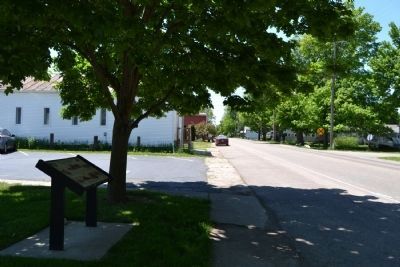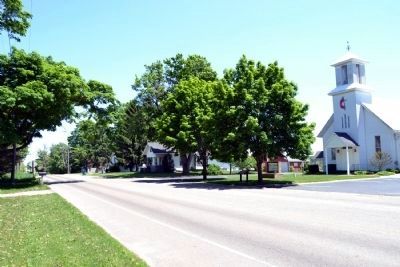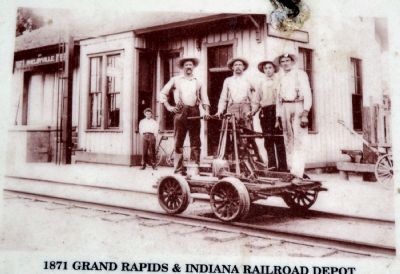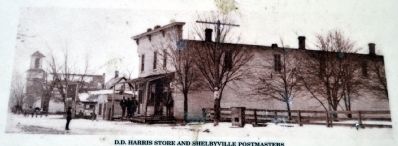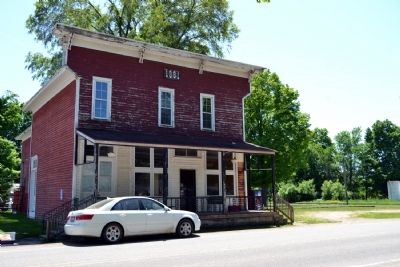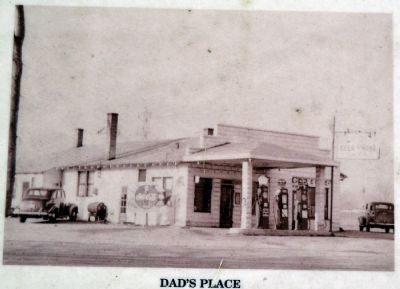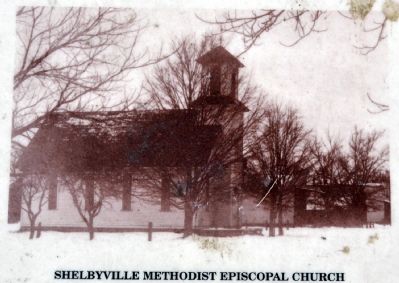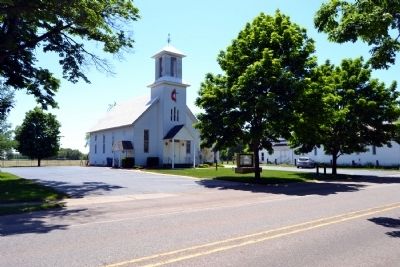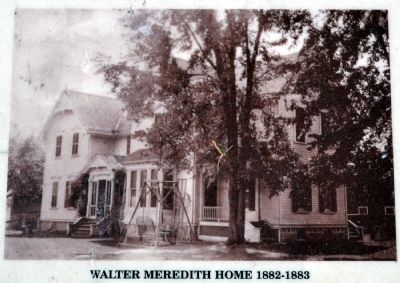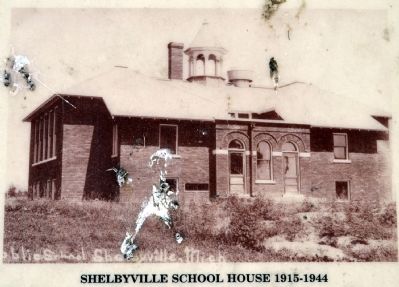Shelbyville in Allegan County, Michigan — The American Midwest (Great Lakes)
Early History of Shelbyville
— Allegan County Heritage Trail —

Photographed By Duane Hall, May 30, 2014
1. Early History of Shelbyville Marker
Allegan County Heritage Trail:br>
Allegan County website entry
Click for more information.
Click for more information.
In the 1870's the Village of Shelbyville was created by the arrival of the Grand Rapids and Indiana Railroad. Shelbyville was named after the first railroad station agent, Mr. Shelby. Since there was already a Michigan town named Shelby, the “ville” was added to his name. Shelbyville was one of the largest shipping points between Kalamazoo and Grand Rapids. Just south of the depot were livestock yards, where droves of cattle, hogs and sheep came for shipment.
1871 Grand Rapids & Indiana Railroad Depot
The railroad depot was built on the southwest corner of 124th Avenue and the railroad tracks in Martin Township. The first wood burning engines arrived in 1871.
D.D. Harris Store and Shelbyville Postmasters
The D.D. Harris store was built in 1881 by Schroeder and Olin of Galesburg, Michigan. D.D. Harris came to Shelbyville in 1882 to run the general store.
Leonard Doxey was appointed the first Shelbyville Postmaster in 1871 conducting his duties from his residence. He served for thirteen yeras and was succeeded by Fremont Young.
In 1886 D.D. Harris, a republican, became postmaster and served through his general store. In 1901 he received a letter from the office of the Postmaster General, Washington, D.C. authorizing him to establish Shelbyville’s 1st rural delivery route beginning February 1, 1902.
Fred H. Herbert was appointed the first rural mail carrier at an annual salary of $500.00 including horse hire. He drove the 25-mile route with 140 stops by horse and covered wagon and later on motorcycle. In 1906 James E. Adams was appointed rural carrier and faithfully served for 32 years until 1938.
D.D. Harris served as postmaster a total of 49 years until his retirement in 1940. There was a four-year interlude while the democrats were in office, during the Cleveland Administration.
Interurban Depot 1915-1926
The Michigan Electric Railway Company known as the “Interurban”, operated by its “third rail” between Kalamazoo and Grand Rapids, and from Allegan through Monteith Junction to Jackson. The Shelbyville Interurban Depot was located just west of Tenth Street on the south side of 124th Avenue and operated from 1915, ending in 1926. Shelbyville was a favorite stop for vacationers coming to Gun Lake.
Dad’s Place
Dad’s Place, located on the northwest corner of Tenth Street and 124th Avenue, where sandwiches, beer, wine and gasoline were sold in the 1930's and 40's. Local business is still thriving on the corner as “Shelbyville Tavern”.
Shelbyville Methodist Episcopal Church
The Shelbyville Methodist Episcopal Church was built in 1885. Reverend L.W. Calkins, as well as many of its
members, were given much credit for building the church. D.D. Harris donated the nails, hardware, lathe and plaster. Lumber for the pews and altar came from the Meredith farm, with Walter Meredith himself building the railing. The bell was donated by Ben Smith, whose early death necessitated swift work, so that it might toll of the first time at his funeral.
Walter Meredith Home 1882-1883
The Walter Meredith home was built in 1882-83 from timber cut and sawn locally at a cost of $4,000. Mr. Meredith built the home himself finishing the rooms beautifully in cherry, oak and black walnut. The black walnut staircase was built from lumber obtained from John C. Wheeler farm, a neighbor to the south. Mr. and Mrs. Meredith operated their large beautiful residence as a hotel for several years.
Shelbyville School House 1915-1944
On the northeast corner of Tenth Street and 124th Avenue a large two-story brick schoolhouse was built in 1915, to replace the white frame building moved there in 1885. Classes were held in the brick schoolhouse until 1944 when the district was consolidated with the Wayland Martin School Districts.
Erected by Charles and Betsy Hill and the Allegan County Tourist Council. (Marker Number Stop 26.)
Topics. This historical marker is listed in these topic lists: Churches & Religion
• Education • Railroads & Streetcars • Settlements & Settlers. A significant historical date for this entry is February 1, 1866.
Location. 42° 35.655′ N, 85° 38.093′ W. Marker is in Shelbyville, Michigan, in Allegan County. Marker is on 124th Avenue east of Pearl Street, on the right when traveling east. Marker is located in front of the Shelbyville United Methodist Church. Touch for map. Marker is at or near this postal address: 938 124th Ave, Shelbyville MI 49344, United States of America. Touch for directions.
Other nearby markers. At least 8 other markers are within 8 miles of this marker, measured as the crow flies. Geib Veterans Memorial (approx. 3.8 miles away); Early History of Martin (approx. 4 miles away); Henika Ladies Library (approx. 5½ miles away); Welcome to Wayland (approx. 5½ miles away); U.S.S. Maine Memorial (approx. 6.8 miles away); Welcome to the Village of Hopkins (approx. 6.8 miles away); Hopkins Township Veterans Memorial (approx. 6.8 miles away); Bowen's Mills (approx. 7.2 miles away).
More about this marker. The marker is at Site #26 of the Allegan County Heritage Trail (driving tour).
Credits. This page was last revised on August 5, 2023. It was originally submitted on June 19, 2014, by Duane Hall of Abilene, Texas. This page has been viewed 1,142 times since then and 112 times this year. Photos: 1, 2, 3, 4, 5, 6, 7, 8, 9, 10, 11, 12. submitted on June 19, 2014, by Duane Hall of Abilene, Texas.
